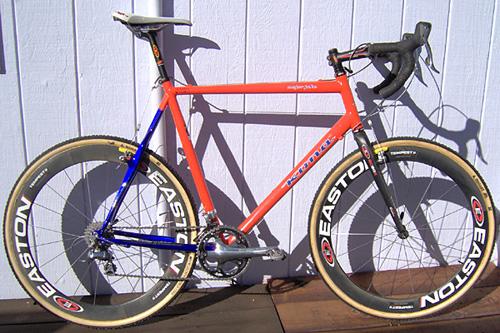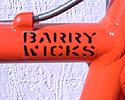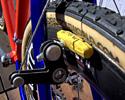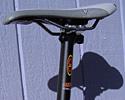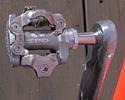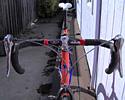
Recently on Cyclingnews.com |
Pro bikes, December 14, 2006
Barry Wicks' Kona Major Jake
Oversized everythingBy Kirsten Robbins Kona is the title sponsor of a handful of the top cyclo-cross riders in the North America. Their most consistent rider has been Barry Wicks, winner of the 2005 US Grand Prix Series and member of the 2004-2005 U.S. cyclo-cross world championships team. Wicks gave Cyclingnews a short history on how he became one of North America's best cyclo-cross riders as well as a detailed breakdown of the machine he rides. Wicks started as a junior in Oregon, first racing in the 'Cross Crusade series and then making a quick progression to collegiate national champion in 2003. His transition was smooth from amateur to professional, and he has ridden a Kona through each stage of his career. "Kona has sponsored me for four years," Wicks said. "I had enough time to grow and my sponsors gave me the opportunity to make the right progressions. I had previously ridden for local teams in Oregon - shop teams. I started riding with Eric Tonkin, my mentor in those days. He was riding a Kona at the time and through that connection I met the people at Kona and joined their team." Wicks admits that his primary contract with Kona was for his expertise on the mountain bike but the company has since noticed his talents on the road and in cyclo-cross at the professional level. "I focus on mountain bike in the summer and 'cross for the winter," Wicks said. "It is nice to have two seasons and be able to completely focus on both." The Geoff Proctor European Cyclo-cross camps support Wicks in his ventures to Europe during parts of December and January. "I do about ten races during Christmas time," Wicks said. "I live in the USA Cycling house in Belgium and travel to all the races from there. I have raced the cyclo-cross world championships for the past two years." Though many North American riders dream of racing as a professional cyclist in Europe, Wicks does not share the same passion even if he has the ability to be competitive overseas. He reminds us that the jump from being a top rider in the US to being competitive in Europe is a very big one. "I am happy racing in the USA and I don't know if I am cut out for the hard life of being a Belgian 'cross racer," Wicks said. For the time being Wicks focuses his energy on the US Grand Prix, the national championships and selection for the world championship team. He revealed that he has changed his focus this year with plans of taking the last half of his season much more seriously. "My focus is nationals and beyond to worlds," Wicks said. In terms of equipment, Wicks follows the mantra of, 'Why change it if it works perfectly?'. In fact, prior to this season, he had ridden the exact same frame every year without change. Proportionally speaking, Wicks is rail-thin with only 79kg (175lbs) on his 1.9m (6'4") frame, but he still falls at the upper end of the weight spectrum as compared to his less vertically gifted competitors. Thankfully, his Kona Major Jake with Easton Ultralite Race tubing doesn't add much more, weighing in at just 8.3kg (18.3 lb). This year the bike arrived with two important upgrades: carbon fiber seat stays and a 'shoulder groove' cut out of the frame on the bottom half of the top tube. "The carbon fiber gives compliance to the frame making it lighter and a better ride," Wicks said. "The carbon damps the vibrations better when off road and it rides smoother than aluminum. The flat cut out is more comfortable; we don't carry the bike that much but it definitely creates the ideal cross bike - It is a nice feature to have." He also notes that few companies have made the full carbon fiber transition in cyclo-cross frames because it is expensive and the bikes need to be able to withstand ample abuse. In his opinion, the technology is not quite there, yet. The main attraction to Wicks' frame is its size. When asked what unique characteristics his bike entails he joked: "the only unique feature is that I am humungous and so is my bike - I attract a following of people who are tall!" He and his Kona teammate, Ryan Trebon, have had their frames custom built to suit their tree-like statures. "Ryan and I worked with a few custom builders to find our ideal bike size. We then gave all those measurements to Kona and they adapted that to our frames and built us bikes that fit." Wicks' adjustments start with his 63cm frame because Kona's largest stock frame is 60cm. The length of his top tube is 61 cm and the head tube length is only slightly taller relative to a stock frame size. "We used to run a lot of spacers on a regular bike because the head tube was a little short so now our head tubes are 205mm; originally they were 195mm. This increase was relatively a smaller amount for the size of the bike in order to keep us in a lower race position," Wicks said. He also keeps his measurements consistent at 72.7 degrees for both his head tube and seat tube angles. You won't find many differences when comparing Wicks' road set up to his cyclo-cross set up. One small difference is that he rotates his Easton EC90 SLX handlebars higher on his Easton EC70stem. This allows for the same reach but allows for better maneuverability for the tricky turns of cyclo-cross. As far as components go, Wicks swears by his stock Shimano Dura-Ace because it is light and it works great. "Stock Shimano Dura-Ace components are bombproof and never an issue. I know everything is going to work right and I never have to worry about them," Wicks said. He rides 175mm Shimano Dura-Ace cranks, another indication of his height, with a smaller FSA chain ring ratio of 47/39T because he is never riding as fast in cyclo-cross as he is on the road. Perhaps the most important aspect of a cyclo-cross rider's bike is his choice of wheels and tyres. Wicks upgraded from his last year's Mavic Ksyriums to this year's Easton Tempest II Carbon race wheels. "It is a big advantage to have a deep-dish carbon rim for racing," Wicks said. "It rides through the mud and sand better and they don't pack up with mud sticking to them - your wheels stay cleaner. They are light wheels and in cyclo-cross there are a lot of changes in acceleration, stopping and going, so there is less weight to get going again after you slow down." Wicks chooses to ride Andrea Dugast Typhoon Flying Doctor tyres, straight out of Belgium. "Everyone who is anyone in Europe rides these tires," Wicks said. "Dugast makes them in his little shop in Belgium and they are in hot demand, really expensive and he does not sponsor anyone." The large and supple 32c tubular casings allows for riding with lower pressure, a key feature to every cyclo-cross rider. Wicks notes that they are comfortable to ride but they are also durable and fast. "They are kind of like riding on big balloons: great for riding on bumpy terrain to float over it instead of bouncing over it." Dugast actually makes two cyclo-cross treads: the Typhoon for dry circuits and the Rhino for the mud, and both are available with 30c, 32c or 34c casings. PhotosFor a thumbnail gallery of these images, click here Images by Kirsten Robbins/Cyclingnews.com
| |||||
Full specificationFrame: Kona Major Jake, TIG-welded Easton Ultralite Race |
Critical measurementsRider's height: 1.9m (6'4") | ||||

